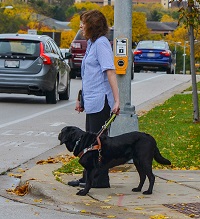
The most important safety tip to reduce pedestrian injuries and fatalities is to pay attention. A pedestrian can significantly reduce the chance of a collision with a motor vehicle by obeying traffic rules and being aware of dangers posed by cars.
Drivers also have a responsibility to create a protected space for pedestrians to travel safely. It’s required by state law.
Drivers must:
- Yield to pedestrians when crossing a sidewalk or entering an alley or driveway
- Yield to pedestrians who have started crossing at an intersection or crosswalk on a walk signal or a green light, if there is no walk signal
- Yield to pedestrians who are crossing the highway within a marked or unmarked crosswalk at an intersection where there are no traffic lights or control signals
- Not overtake and pass any vehicle that stops at an intersection or crosswalk to permit a pedestrian or bicyclist to cross the roadway safely.
Pedestrians must:
- Yield to drivers when crossing a road where there is no intersection or crosswalk or where the pedestrian does not have a green or walk signal and where vehicles have a green signal
- Not suddenly move into the path of a closely approaching vehicle that does not have sufficient time to yield for a pedestrian
- Walk on and along the left side of a highway when not walking on a sidewalk. Note: This law does not apply to bicycles. Bicycles operate under the same laws as other legal vehicles on the road and should always stay on the right side of the road.
Reminders for drivers
- Slow down to or under the posted speed limit in neighborhoods, school zones, playgrounds and swimming pool and park areas.
- Where there are children, keep your foot over the brake to stop quickly if needed. Crashes that happen at low speeds are less harmful.
- Remember that children and adults have the right to be on the street on in-line skates or on a bicycle, even two abreast, if obeying traffic laws.
- Always stop for a blind pedestrian, child or adult with a white cane or a dog guide. Let them complete their crossing before you move your vehicle.
- Be alert for children around school buses and bus stops. If red lights are flashing, you must stop at least 20 feet back. Yellow lights mean you may pass, but cautiously, expecting children. See school bus safety laws for more information.
- Put the phone down. Pay close attention to the road ahead.
Reminders for pedestrians
- Pay attention. Obey traffic rules watch for cars in your area. Make eye contact with drivers if possible.
- Walk on sidewalks whenever available. If there is no sidewalk, walk facing traffic and as far from traffic as possible.
- Cross streets at crosswalks or intersections. If a crosswalk is not available, find a well-lit area with a clear view of traffic and wait for a gap that allows enough time to cross safely.
- Don’t drink and walk. Unlike driving under the influence of alcohol or other drugs, walking may not result in the death or injury of someone else - but it could very well result in yours. If you’ve been drinking, take a cab or a bus, or let someone sober drive you home.
- Take extra care at night and at dusk. Walking at night increases your chances of death or injury. Drivers cannot avoid what they can’t see. When walking at night, wear retro-reflective outdoor clothing, shoes, or lights to make yourself more visible. Avoid wearing dark clothing. Don’t assume drivers can see you.
- Provide proper supervision and training for children. Young children often lack the judgment and experience to make good choices in traffic. Their smaller stature also makes them harder for motorists to see. Adults need to take special care to teach children to behave safely when they are around vehicles. Reference the kids pedestrian safety page for tips.